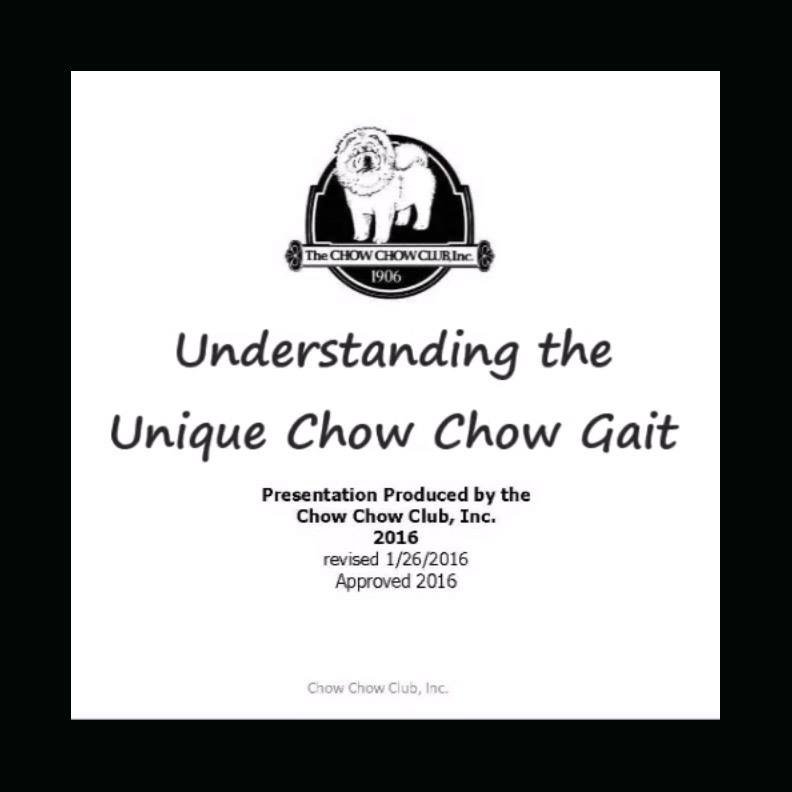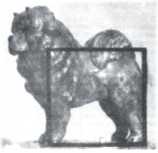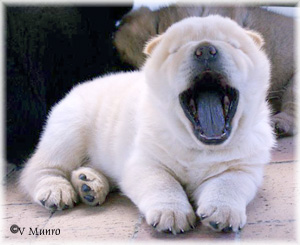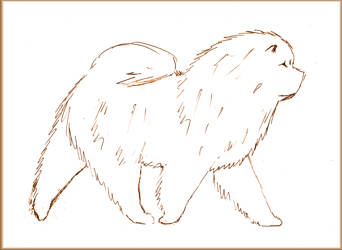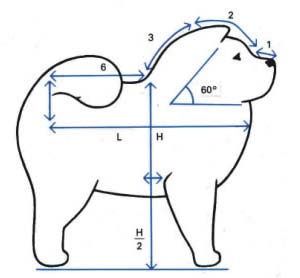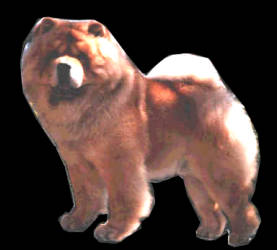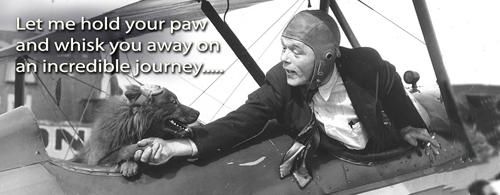Chow Chow Africa education
Best for the breed -
breeders And Judges Education
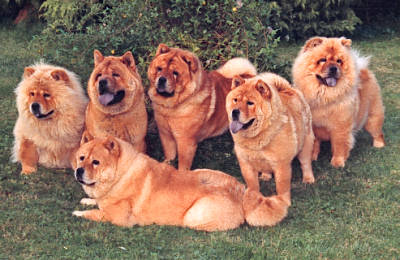
The Complete Chow Chow
-
An Overview for the Judge
and Breeder.
by Specialist Judge - Dr Samuel Draper, Liontamer Chow Chows, USA
A bit of background on the author:
Dr Draper was also an all-breeds judge that had extensive judging experience internationally.
He was a foundation member of the Society for Preservation of the Smooth Chow Chow in the USA & was recognised internationally as a doyen of the Chow Chow.
When I first judged Chow Chows in the spring of 1971, I was examining the first class of senior puppies. When I kept feeling the dog’s ears, unattractively big, incorrectly placed and somewhat floppy, the exhibitor smiled: “Oh, I’m so glad you like this puppy’s ears. You know, I specialise in big ears!” As I swallowed hard, she retorted: “You realize of course, that big ears are hard to breed.” At that moment, and many times in the past and on many occasions since, I have seen evidence that some judges and breeders have become overly occupied with - if not obsessed by - certain aspects of Chow Chow anatomy and/or exterior and never quite see the dog in its entirety. To state the problem in different words: some judges and breeders of Chows either ignore or exaggerate some serious faults or likewise minimise or overemphasize important strengths. Both procedures are faulty and inconclusive whether one is judging or breeding Chows or any other dogs. Rather one must evaluate the all-over dog, in this case, the all-over Chow, indeed, the complete Chow.
What I wish to accomplish here is an overview for the judge and breeder, emphasizing the complete Chow by means of looking briefly at his anatomical structure and his outward picture by means of illustrations. Reflecting for a moment on that episode involving the exhibitor with the senior puppy with poorly placed ears, I wish I could report that I had quipped in reply: “I congratulate you madam, on turning liabilities into assets!” But instead, I remained diplomatically silent, confident that she had never read the Chow Standard which calls for small ears, placed wide apart on the top of the skull. Fortunately this woman is no longer in Chows or in any breed!
First a brief look should be given to illustration 1 which shows the skeletal make-up of the Standard Schnauzer, specifically, but which demonstrates as well the bone structure of most breeds generally. The drawing shows a dog whose shoulders are well laid-back, so to speak, the shoulders sloping well forward to the point where they join the upper arm, forming as nearly as possible a right angle when seen from the side. In other words, the angle that the scapula (shoulder blade) forms with the humerus (upper arm) is close to a right angle. The shoulder blade represents about a 45 degree angle. Notice that the upper arm is about the same length as the shoulder blade. In the rear, this breed has slanting thighs (the femur) well bent at the stifle joint (true knee or patella). This angulation will provide a good reach which will co-ordinate the dog’s movement in front. Because of the well laid-back shoulders and upper arm of sufficient length, the dog's reaching in front will co-ordinate with the dog’s strong drive in the rear.
 Illustration
1:
Illustration
1:
How height and length are measured in the dog.
Height is measured from a point horizontal with the withers
straight down to the ground (line A).
Length is measured from point of shoulder to point of buttock (line
B).
Reproduced by permission.
from “Illustrated Discussion of the Miniature
Schnauzer Standard”, drawing by Loraine L Bush
Also of importance here is the manner in which most dog’s heights and lengths are measured. The height is measured from a point horizontal with the withers, straight down to the ground (Line A). The length is measured from the point of shoulder (Line B). What these proportions indicate is that in this dog - and in most breeds the height squares with the length of body. This idea is meant when one hears that a dog is square. The Standard Schnauzer Standard reads: “Square built” as well. Likewise the Dobermann Standard explains: “The appearance is that of a dog of medium size with a body that is square.’ and the Boxer is also a square. So it is with many dogs.
Furthermore understanding this idea of the square dog will be helpful when judging and breeding the Chow. The Chow is a square dog. (See Illustration 2). The American Chow Standard reads “Body squares with the height of leg at shoulder.” This squareness should be stressed repeatedly. A chow that is not square is a dog that is too long in body for his height. Or to indicate the same thing in different words: his legs are too short for the length of his body. Every Chow Standard in the world today defines the Chow as square, in that the body squares with the height at shoulder. Unfortunately, some judges and breeders do exist that ignore - indeed shut their eyes to this important attribute of the Chow. His squareness.
In studying the Chow Chow in Illustration 2 further, one sees that the Chow’s shoulders are not well laid-back or sloping as most breeds’shoulders are. The Chow Standard points out “Shoulders muscular, slightly sloping.’ If one knows dog structure and movement, it is clear that a chow does not 'reach out’ in front as most breeds do. Since the Chow has a straight stifle and hock, without the usual bend of stifle, the Chow cannot cover the ground that a dog can that is well-angulated in the front and rear. The slightly sloping shoulder of the Chow should be about 60 degrees according to most Chow specialists, including Dr JoAnne Schmidt O’Brien, whose Linnchow Kennels were well known in the thirties and forties and whose association with the Pandee Kennels today puts her in the forefront of knowledgable breeders. Of course, a 60 degree angle for the shoulders or scapula is only 30 degree from being completely straight or parallel to the dog’s front. The relatively straight upper arm or humerus as well as the rather straight shoulder, tend to co-ordinate and balance with the straight stifle and hock in the rear. In short, the Chow tends to be somewhat straight in the front and quite straight in the rear.
Because of these anatomical facts, the Chow moves in a stilted manner, not in a smooth or steady gait nor a flowing one such as the gaits of the Dalmatian or Bichon Frise to cite but two examples. Although the Standard does not clarify this completely, the Chow not only has straight hocks but straight stifle joints as well with the tibia bones being as nearly straight as well. The Standard says only a few words in regard to gait, ‘unique in it’s stilted gait’ in other words, a gait which is completely individual to the Chow Breed and which is short and stilted because of the straight hocks. See Illustration 2.
Another area of concern today among the best Chow judges and breeders is the problem of the patella or knee joints where the femur joins the tibia and fibia, or to put it another way, the problem concerns the knee joints or the bend of stifle. Have another look at Illustration 2. Some judges and breeders pay too little attention to a rubbery slipping knee-cap or patella that contributes to a swerving, rubbery, defective movement that is not correct. Some Chows back legs are so wobbly from a slipping knee-cap hat the dog cannot put sufficient weight on his rear legs in order to walk around the ring. Some uninformed observers of our breed have been heard to remark about such rear action: “Oh, well, nobody understands Chow movement anyway. What difference does it make?” If a Chow has a subluxated patella or slipped knee-cap, the Chow is not a healthy dog, nor can he move correctly. One can feel the difference between a normal knee-cap and a slipping, sliding patella. The correct patella or stifle joint feels solid and muscular, this incorrect one like sliding jelly!
The next idea concerns the correct placement of the Chow’s ears. The Standard asserts in regard to ears “Small, thick, slightly rounded at the tip, carried stiffly erect, but placed well forward over the eyes and wide apart” (AKC disqualification: Drop ear or ears. A drop ear is one which is not stiffly carried or stiffly erect, but which breaks over at any point from it’s base to it’s tip.) See illustration 5 A. A small ear is a small ear and means only a small ear. Recently, one participant in a Chow Symposium given by Dr O’Brien, in regard to breeding chows, sponsored by the Chow Chow Club of Greater New York, asked her the following: “What do you mean by small ears? What is small?” “In breeding Chows for fourteen generations,” Dr O’Brien pointed out “I”ve never seen an ear which was too small, have you?” Her reply was almost repartee, humorous yet, but directly to the point. (no pun intended).

Many Chows today have big ears which tend often to be loose, often floppy, not broken over at any point, however a broken ear is not what is being alluded to here. It is the large ear that is not always erect, but sometimes loose and pushed back, not stiffly carried or erect. Often these ears tend to be placed on the side of the head, not on top of the skull which is proper (See Illustration 5 B). These ears are too large and are set on the side of the dog’s head. Ear set as pictured in 3 B is a common fault which handlers and exhibitors try to cover up or minimise by pulling the Chow’s lead up lightly to push the big offending ears higher on the top of the head. In looking further, one sees in Illustration 3C that the ears are obviously set too close together on top of the skull, being slightly too pointed as well, giving a frightened “rabbit-like” look. Illustration 3A represents the correct ear placement. In discussing this appropriate ear set with Percy Whittaker of Great Britain, Henk van der Wouw of the Netherlands, Paul Odenkirchen of Canada and Prudence Baxter of the United States, all important, eminent authorities on the Chow, they are in complete agreement - their consensus about ear placement is as follows: the outer edge or left extremity of the left eye should align itself with the inside edge of the left ear. (One’s orientation is facing the Chow). Then of course, it follows that the right extremity of the right eye would align itself with the inside edge of the right ear. See illustration 3A in which the dotted line indicates the correct alignment as described above.
Illustration 4 depicts a beautiful Chow head, representing what the majority of breeders are producing todayin this country, in Canada, Europe and to some extent in England although the English head tends to have fewer wrinkles over the eyes, which are not as deep set as those shown in Illustration 4. (Since most breeders and judges recognise the proper head as illustrated here or only slight deviations from that pictured in Illustration 4, no more time will be taken up with the head per se.)
However, one of the most dramatic reasons for writing this evaluation does concern some judges and breeders tendencies to over emphasize the importance of a Chow’s head. We have all heard that the Chow is a “Head breed” so that if he has a big, magnificent head with lots of wrinkles, deep set eyes, he is a great Chow. NONSENSE! A great Chow or even let us say a correct Chow, or a Chow that is deserving of some winning, must have a big, beautiful head, granted, but he must have much more as well! THE OVERALL VIEW OF A CHOW, IS ONE OF SPLENDID PROPORTIONS, and BALANCE, a SQUARE Chow, not a rectangular one. Quite often some strikingly handsome Chow heads are walking around, nearly on their heads alone, a grotesque sight, for they have insufficient leg to balance with the length of body. Of course, a magnificent head is desirable, but a good Chow must be sound, he must be well-balanced; he must have the correct ear set, the correct dark eye, the requisite blue-black tongue and pigment; he must move with stilted gait, being straight hocked and stifled; he must form a complete picture of harmony and balance, a perfect square of handsomeness. The complete Chow Chow must be considered. Additionally, Illustration 5 shows a short legged or long-backed Chow or one that is not balanced in that his height at the shoulders makes a rectangle not a square. According to most authorities in the world, a short-legged Chow is a deformed Chow. The correct Chow should resemble the Arctic breeds more closely than it does a Basset Hound!
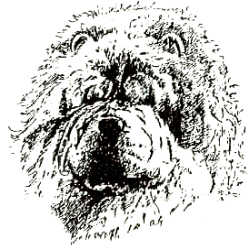 |
Left: Illustration
4 -
An Ideal Head Right: Illustration 5 - UNBALANCED CHOW. Legs too short and/or body too long. |
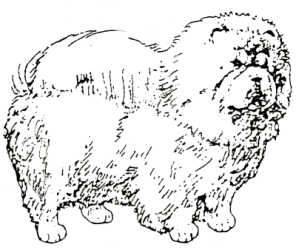 |
The appropriate Chow front is demonstrated in Illustration 6A. The Standard reads “Shoulders muscular and sloping. Forelegs perfectly straight, of moderate length and with good bone. Chest broad and deep.” A narrow chest is a serious fault. The elbows, the upper part of the front legs, should be close to the chest, not under the body, but fitting right against the body. The chest is not only broad, wide from left to right, but it must be well let down from top to bottom The chest should drop down certainly to the fiddle of the elbows. The Chow is a ‘barrel’ chested dog, that is, he has well sprung ribs. The well-sprung Chow as in all dogs, is ascertained by the horizontal distance the rib runs out from the backbone at the top of the back, before the rib slopes downward. If the rib does not extend far out, the Chow is narrow chested or flat chested. THE CHOW SHOULD NEVER BE NARROW-CHESTED. See Illustration 6B. However, no knowledgeable breeder or judge will credit a fat dog as being wide chested. As to the Chow’s forelegs, the standard is specific in demanding perfectly straight, good boned appendages of moderate length.
The front legs measured from the elbows to the ground (the elbow joint is that which joins the forearm or ulna with the upper arm or humerus) should be about HALF THE HEIGHT OF THE DOG measured from the top of the shoulder to the ground. Front straight legs means that the legs should be as closely parallel to each other as possible. See illustration 6A once more. Because the chest must be broad, especially in the brisket, the front legs of the Chow should NOT be close together. Front legs should be straight and parallel and have plenty of space between them. Almost as important for the front legs to be straight, the pasterns should be as straight as possible. Straight pasterns give the Chow an “up on it’s toes” appearance when viewed from the front.
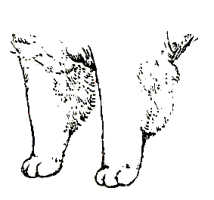 |
Left: Illustration
6A -
Correct Front Right: Illustration 6B - Poor Front |
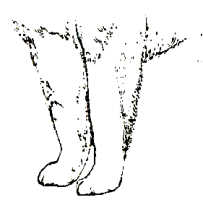 |
In regard to the correct straight hock and stifle joint and admirable - high tail set, illustration 7A demonstrates these points accurately. The Standard explains, “The tail set high and carried well over back”. Illustration 7B gives an example of the poor tail set and shows a tail that is carried too high on the back as well. The tail should lie FLAT on the back. A low tail carriage, of course, make the Chow look longer backed than perhaps he is. The same illustration also demonstrates what is meant by too much bend of stifle and too much bend of the hock joint. Neither is correct.
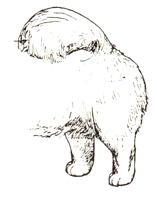 |
Left: Illustration 7A - Correct Tailset Right: Illustration 7B - Poor Tailset |
 |
Finally the last drawing, Illustration 8, shows the IDEAL CHOW. Massive, cobby, powerful, active and alert, this chow demonstrates strong muscular development and perfect balance. His head is broad and flat with a short, broad, deep muzzle, accentuated by a ruff. He is supported by straight, strong legs. His coat is abundant and dense, straight and off-standing, coarse in texture. The Chow’s head is large and massive in proportion to the size of the dog, and has a broad, flat skull, well-filled under the eyes. His head is proudly carried. He is dignified, lordly, scowling, discerning and sober, exuding an inscrutable air of oriental independence, indeed he is a masterpiece of beauty, dignity and untouched naturalness.
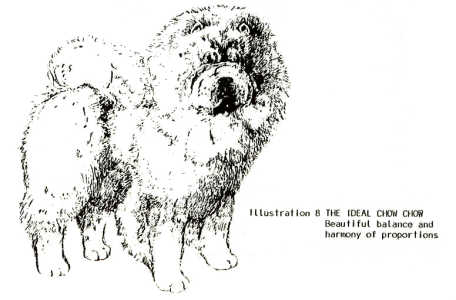 |
To summarize, one’s ability to judge and breed Chows in a successful manner is related to one’s perceptions of the whole Chow, the entire dog, the COMPLETE Chow Chow. To contemplate the concept in terms of human beauty - isn’t a dog show a contest of beauty? One recognises that the most beautiful women and handsome men in today’s society are often said to be professional models. Aren’t they judged according to an overview, a complete picture? Just because a woman has luxurious hair or well shaped legs, she may not be suited to do modelling for she may be short-necked or obese. Likewise, a man who possesses muscular shoulders and arms and striking eyes may be ill-proportioned as to his height and weight and shape of face. These latter characteristics making him ill-suited to being considered a man of near perfection in physical beauty. Certainly an overview is essential both in the animal realm and in human life in regard to physical handsomeness. Beauty and harmony are a matter of balance and proportions, taking into consideration every aspect of the splendid human being and comely Chow Chow. Are we not talking about the ideas that the total or entirety is greater than the sum of it’s individual parts? Yes, we are, and the complete Chow Chow is what breeders and judges should be concerned with.
To sum up, it is important to stress again that it is the entire Chow, the complete animal that is of concern here. The most important part of a Chow’s total picture is his balance, his squareness which has been stressed throughout this article. I must again refer you to Illustration 1 showing the squareness of the Schnauzer and Illustration 2 showing that of the Chow. Although the drawing of the Chow’s anatomy is not professional, nor is it an exact rendering of the Chow’s skeleton - would that each of us had a bit more of the artist in him or her - it was included for two reasons mainly: first, to demonstrate how to measure a Chow’s squareness and secondly to suggest that the Chow is straighter in the shoulder blade and in the upper arm and in the stifle and hock joints than most other breeds such as the Schnauzer for example. The drawing is meant to be a means only to understand the Chow’s squareness and his straightness in front and rear, both ideas made very explicit in the Official Standard. it was never meant to represent an actual Chow skeleton - per se - only a suggestive drawing to assist us in a better understanding of the Chow’s anatomy. In showing the drawing of the Schnauzer and the Chow skeleton to an eminent biologist and canine anatomist, he volunteered that the drawings were correct enough and quite suitable for purposes of illustration of this article.
As to whether a Chow is square or whether he is straight hocked in the hind legs is NOT a matter of conjecture or of interpretation. These are FACTS as stated in the Chow Standard.
Last summer, during a Chow symposium held in Connecticut, a member of the audience asked the following, after having heard virtually the same presentation of ideas as this article illustrates: “Isn’t it just your opinion that a Chow should be square and that his shoulders and hind legs are straighter than most breeds?” And in the same breath, before I had an opportunity to respond, he grumbled something like: “I know some Chow breeders who think their short-legged Chows are correct - and they like them better than the square kind, I guess I’ll just make up my own mind.” My answer was that the official Standard of the Chow Chow should make up our minds for us, the Standard is clear, it states facts about the Chow and such have been followed in this essay. To state that one will make up his own mind about what is correct in the Chow is nonsense. The Standard tells us the fact of what a correct Chow is like. To make up one’s own mind is a concept that simply confirms the ‘egotism’ of the person involved. To question the Chow’s squareness or any facts stated in the Standard is comparable to questioning the scientific truth that the sun is the centre of the universe (demonstrated by Copernicus in 1543)! Although some egotists would prefer to believe that the earth is the centre of the universe! (a non-scientific idea held by Ptolemy of Alexandria) because this position is more flattering to the self-important egotist, such a belief is closer to medieval superstition than modern science or truth.
Truth is truth and it exists outside the individual’s liking or acceptance of such truth. The Chowist who wishes to judge and breed Chows which are correct in their totality and completeness must adhere to the objective truth and facts of the OFFICIAL CHOW CHOW BREED STANDARD.
Unless specifically stated, extracts from the Official Standard used in the article have been changed to conform to the KUSA Standard .... Ed
Wanting to publish these articles or link to them?
Some authors have given permission for these articles to be printed out for private free use internationally, both in national judges' training schemes and for private free education of individuals. However, all articles remain COPYRIGHT of the authors and no copies of these articles may be published in any way without written permission from the authors. For permission please contact the authors directly or please contact the webmaster.
On
the web, it will be appropriate to LINK to the articles which
originally appear on this website.
Acknowledgement of the articles' original appearance on this website
is appropriate and appreciated.
Breed Standards:
More Judging Articles:
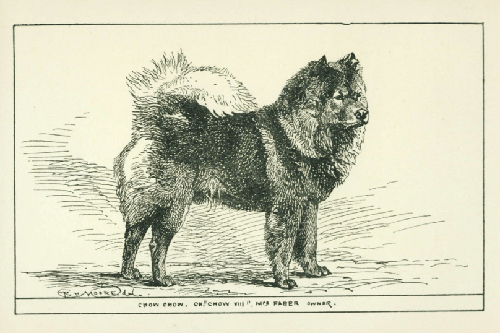 Learn more about the Chow Chow upon which the Breed standard is said to have been based.
Learn more about the Chow Chow upon which the Breed standard is said to have been based.
Learn about the Chow Chow's rich history on the Chow Chow Archives. This will help you understand the need for functional structure and moderate type.
